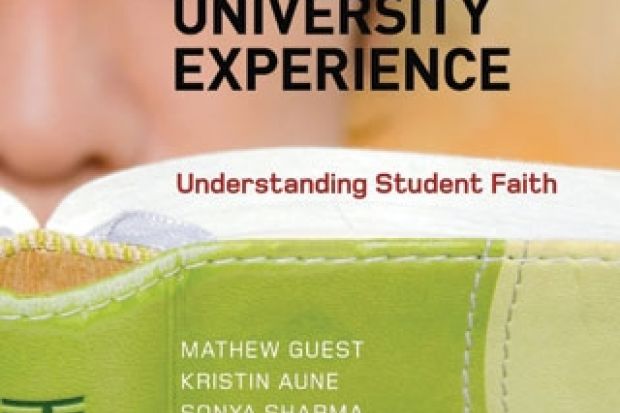This study of the religious experience of Christian students at universities in England is both surprising and most welcome. Surprising, because after almost 60 years of propaganda about the decline of religious faith, one does not expect to find a wide-ranging investigation as specific as this one. It is a study of the religious experience of Christian university students in what we have come to conceive of as secularised Britain. On the other hand, it is most welcome because empirical information carefully gleaned can only promote understanding in the ideological battleground between the die-hard secularists who seem to dominate the academy and the believers (by virtue of their faith deemed ipso facto biased) who appear reactionary and overly defensive.
Mathew Guest, Kristin Aune, Sonya Sharma and Rob Warner have set themselves a modest task: to ascertain how Christian students view their faith within the context of their broad university experience. They present no argument about long-term change or future trends, which is a tendency that sociologists of religion have generally struggled to resist. Many of these projections have faltered on the premise that things proceed along linear lines and that, inexorably, percentages at a given time are indicative of long-term decline or growth. The interconnections between personal faith, participation within communities and formal membership, as scholars including Grace Davie and Robert Wuthnow have shown, are much more complex – illustrated also in the changing habits of declining membership within a range of other voluntary societies over the past 30 years.
The resilience of faith means that we must reconsider the scepticism about the prospects for religious belief in the academy
The authors seek to present a “snapshot” of Christian students studying at English universities at “a single point in time” in order to understand their distinguishing features as a sub-group. Some 4,500 students at 13 universities were surveyed to reflect the diversity of the English university sector, including so-called traditional/elite universities, inner-city redbricks, 1960s campus universities, post-1992s and the Cathedrals Group, which are Church foundations.
The large survey provided details about moral values, personal encounters with matters of beliefs and practice, and religion and social class. Over and above these survey findings, in-depth interviews with 75 students and relevant university leaders helped the researchers in “challenging preconceived assumptions” about the nature of Christian faith and its practice among these students.
In eight concise chapters, the authors explore the diverse structures, challenges and opportunities for personal and communal religious expression at the different universities. One of the chapters specifically explores whether the university is a force for secularisation; another discusses the social cleavages among Christian students, with the final chapter drawing out the implications of this study.
The researchers have uncovered key insights, the most important being that, contrary to what I would have expected, “Christian students – much like UK Christians in general – comprise a sizeable and diverse group” at our universities and “are not unified by doctrine or ethical assent”. The authors argue that “first and foremost” it is the “subjective and relational experience of university that engages with their faith”. Some of the study’s findings are counter-intuitive: for example, that it is not predominantly the case that the university acts as a force for secularisation; that chaplaincies have reinvented themselves from being solely facilitators of denominational Christian interests to becoming “resource centres for social cohesion” and facilitators for interfaith understanding and cooperation; and that “student Christianity is often not as sectarian in its instincts as many sceptics make out”.
So Christian faith and its expression among a sizeable group of university students is alive and well despite the prophecy of its demise. David Martin, one of the best sociologists of religion this country has produced, and Andrew Greeley in the US were among the only voices to challenge their peers in the 1960s and 1970s and question the doomsaying about religion. Gradually, academic opinion altered, with Peter Berger, for example, writing in the 1990s about “why he changed his mind” about the subject.
The resilience of faith among a significant number of university students means that we must reconsider the scepticism about the prospects for religious belief in the academy. Either we make sense of its resilience and value, which is amply evident in our culture, art and literature if we take the long view, or we continue to treat it as an aberration needing something along the lines of Richard Dawkins’ wildly imaginative notion of “memes” or suchlike to debunk it.
While the authors seek simply to present a snapshot, they do promise to build up to a longitudinal study, which can only add value to our thinking about this important cultural issue. I look forward to the next piece in this jigsaw.
Christianity and the University Experience: Understanding Student Faith
By Mathew Guest, Kristin Aune, Sonya Sharma and Rob Warner
Bloomsbury, 256pp, £65.00 and £21.99
ISBN 9781780936017, 37847 and 36215 (e-book)
Published 12 September 2013
Register to continue
Why register?
- Registration is free and only takes a moment
- Once registered, you can read 3 articles a month
- Sign up for our newsletter
Subscribe
Or subscribe for unlimited access to:
- Unlimited access to news, views, insights & reviews
- Digital editions
- Digital access to THE’s university and college rankings analysis
Already registered or a current subscriber? Login




